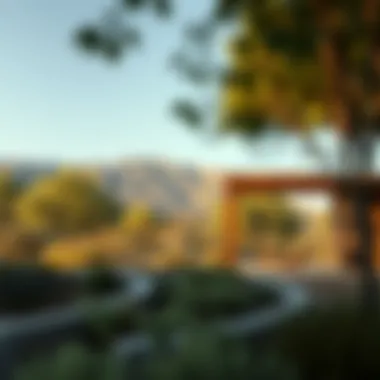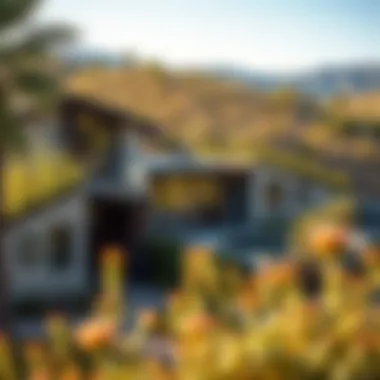Eden in the Valley: Master Plan Insights and Implications


Intro
The Eden in the Valley master plan is not just another development in the bustling landscape of Dubai's real estate market; it is a visionary project aimed at reshaping the very fabric of community living. This initiative brings together innovative design, strategic planning, and a keen eye on sustainability, setting the stage for something truly remarkable. To fully grasp its potential, we need to dive into various aspects of the plan that give it depth and relevance in today's dynamic market.
Market Trends
In examining the market trends surrounding Eden in the Valley, it becomes evident that this project is positioned at a pivotal moment in real estate. The interaction between global economic shifts, local regulations, and changing consumer preferences plays a crucial role in determining its success.
Current Market Analysis
Dubai's real estate scene has seen a fluctuation of interest levels, driven largely by the region's diversification and economic resilience. Currently, properties in well-planned communities, like Eden in the Valley, are attracting both international investors and local buyers. A notable aspect of this project is its mixed-use development strategy, which caters not just to residential needs but also incorporates commercial spaces and recreational areas. This holistic approach appeals to a wide demographic, from young families seeking community to investors looking for stable assets.
The demand for environmentally conscious designs continues to rise, aligning seamlessly with Eden in the Valley's focus on sustainable architecture. Elements such as green spaces, energy-efficient buildings, and communal facilities are becoming selling points.
Future Projections
Looking ahead, the landscape appears promising. Analysts suggest that the demand for well-structured residential communities is set to increase significantly, influenced by trends such as remote working and a preference for suburban lifestyles. Furthermore, projects like Eden in the Valley are likely to bolster the value of properties in the surrounding areas.
Investors can expect a steady influx of demand driven by the project's anticipated completion timeline and integration of lifestyle amenities. In addition, Dubai's ongoing economic advancements, combined with strategic government initiatives aimed at boosting tourism and investment, create a fertile ground for growth in the real estate sector.
"The Eden in the Valley project isn't merely a development; it's a blueprint for the future of urban living, focusing on sustainability and community engagement."
Investment Strategies
With the promising outlook surrounding Eden in the Valley, prospective investors must approach this opportunity with a well-structured strategy in mind.
Best Neighborhoods to Invest In
While the entire Eden in the Valley project will offer appealing options, certain neighborhoods are already capturing attention. For instance, areas closer to communal parks or commercial hubs may fetch higher demand and appreciation rates in the future. Locations attached to public transport links stand a better chance of attracting tenants and buyers alike.
Tips for First-Time Investors
- Do Your Homework: Understand the zoning regulations and community development plans that may influence property values.
- Consult Professionals: Collaborating with real estate agents who specialize in the Dubai market can provide invaluable insights.
- Consider the Long-Term: Investments in properties like those in Eden in the Valley should be viewed as long-term holdings, given the projected growth of the area.
- Stay Informed: Regularly monitor market trends and reports from reliable sources to stay ahead of changing dynamics.
For in-depth analysis and ongoing updates, resources such as Wikipedia, Britannica, and Reddit offer invaluable insight into local real estate trends and perspectives.
Engaging with data from government websites or educational institutions will enrich your understanding of market opportunities. As the Eden in the Valley initiative unfolds, informed investors will be well-positioned to capitalize on this unique development.
Overview of Eden the Valley
The Eden in the Valley project stands as a pivotal initiative within Dubai's ever-evolving real estate scene. A careful analysis of this endeavor sheds light on its multifaceted framework and the strategic considerations that underpin its design. Recognizing the importance of this topic is critical not only for stakeholders directly involved but also for investors and market observers keen on understanding future trends. The overall significance of Eden in the Valley lies in its potential to reshape the residential and commercial landscape of Dubai while fostering community spirit and environmental sustainability.
Foreword to the Project
The Eden in the Valley project represents a forward-looking alignment of urban development with ecological sensibilities. As land scarcity becomes increasingly pressing, this initiative aims to maximize the use of space without sacrificing green aesthetics. With an emphasis on blending sophistication in living spaces with natural beauty, this project seeks to establish a haven for families, professionals, and individuals alike. It’s not merely about bricks and mortar; it’s about crafting a lifestyle that resonates with the aspirations of modern urban dwellers.
Key Stakeholders
Key players within the Eden in the Valley initiative comprise a diverse group of entities, each contributing unique insights and expertise. From government bodies focused on regulatory compliance to private developers straddling the fine line between ambition and feasibility, the collaboration feels like a well-orchestrated symphony. Moreover, local communities and environmental NGOs are essential in guiding the project to reflect genuine urban needs and ecological well-being. A collaborative approach sets the stage for dialog among these stakeholders:
- Government Agencies: Ensuring adherence to zoning laws and building codes, facilitating approvals.
- Investors and Developers: Bringing in capital and innovative designs that align with market demand.
- Environmental Groups: Advocating for sustainable practices and conservation efforts in the development plans.
Strategic Vision
At the heart of Eden in the Valley lies a strategic vision focused on creating a harmonious blend of urban living with natural tranquility. This vision strives to address prevalent urban issues like overcrowding while offering the attractiveness of open spaces and integrated community facilities. Key elements of this strategic plan include:
- Mixed-use Areas: Allowing for residential, commercial, and leisure spaces to coexist, fostering a vibrant community life.
- Sustainability Initiatives: Incorporating renewable energy sources and environmentally friendly practices which can truly minimize the carbon footprint.
- Public Transportation Plans: Crafting a network that reduces dependence on private vehicles, intuitive paths for pedestrians and cyclists contribute to reducing traffic congestion.
In essence, the strategic vision for Eden in the Valley is not merely about constructing buildings, it’s about crafting respectful spaces that contribute positively to the social fabric of Dubai.
Design and Architecture
The design and architecture of the Eden in the Valley plan are pivotal in shaping the livability and aesthetic appeal of the development. Every architectural decision intertwines with the community's functionality, influencing how residents interact with their environment. A thoughtfully constructed area can foster connectivity, promote sustainability, and enhance the overall quality of life for its inhabitants. As one delves into the intricate tapestry of this project, it becomes clear that the balance between innovation and tradition plays a significant role in its success.
Architectural Styles
Exploring the various architectural styles adopted in Eden in the Valley reveals a blend of modernity and cultural heritage. The design reflects a commitment to integrating local cultural elements into contemporary frameworks, celebrating both the spirit of the region and modern aspirations.
- Contemporary Aesthetics: A focus on clean lines, open spaces, and natural materials harmonizes with cutting-edge technology. This style not only prioritizes practicality but also aims to create environments that connect emotional well-being with physical spaces.
- Traditional Middle Eastern Influences: To ensure the development resonates with the local heritage, architectural motifs reminiscent of Middle Eastern designs will be present. Arched entryways, intricate tile work, and shaded courtyards create not just buildings but community hubs that tell stories.
- Mixed-Use Designs: Welcoming an array of functionalities within a single structure, mixed-use designs encourage a lively atmosphere. Residences, offices, and retail spaces under one roof cultivate a sense of community and convenience, attracting diverse demographics.


This confluence of styles in Eden in the Valley shapes not just the skyline but also the community’s identity.
Sustainable Design Principles
In today’s world, sustainability is a critical consideration in any development plan. Eden in the Valley aims to set a precedent in environmental consciousness through meticulous attention to sustainable design principles.
- Energy Efficiency: Buildings in this master plan will utilize energy-efficient technologies such as solar panels and smart home systems, reducing the overall carbon footprint. These initiatives align with global sustainability efforts while appealing to environmentally minded investors.
- Sustainable Materials: A commitment to using locally sourced and recycled materials minimizes environmental impact while supporting local economies. This thoughtful selection fosters a greener construction process without compromising quality.
- Smart Water Management: Innovative approaches to water management, such as rainwater harvesting and greywater recycling systems, ensure that resources are conserved for future generations. This system not only supports the environment but also delivers long-term cost savings for homeowners.
Integration with Nature
Creating a seamless bond between the built environment and the natural landscape is a cornerstone of the Eden in the Valley design philosophy. Integration with nature enriches the urban experience, allowing residents to flourish in harmonious surroundings.
- Green Spaces: The incorporation of parks and green corridors throughout the development encourages outdoor activities and builds community ties. By prioritizing green spaces, the project promotes biodiversity and provides habitats for local wildlife.
- Landscape Design: Thoughtful landscaping that employs native plants aids in fostering ecological balance while requiring minimal irrigation. This aligns with water conservation efforts and ensures lower maintenance costs in the long run.
- Natural Light and Ventilation: Architectural features such as large windows and strategically positioned verandas maximize natural light and airflow, creating healthier indoor environments. Not only does this reduce reliance on artificial lighting and air conditioning, but it also enhances the overall quality of life for residents.
"A well-designed community is like a well-written novel; it captures the essence of the place and the lives it nurtures."
In summary, the design and architecture of Eden in the Valley are not just about aesthetics; they embody a vision for the future. By prioritizing sustainable methods, blending traditional styles with modern needs, and maintaining a strong connection to nature, this master plan sets a high bar for future developments. Successful execution will resonate far beyond physical structures, fostering a vibrant community that reflects the rich culture and promise of Dubai.
To gain further insights on sustainable architecture, resources like Wikipedia and Britannica provide in-depth knowledge.
Regulatory Framework
The Regulatory Framework forms the backbone of the Eden in the Valley project. It establishes the rules and guidelines that dictate all aspects of development, ensuring that it aligns with broader urban planning objectives and legal requirements. Understanding this framework is crucial not just for compliance, but also for fostering a harmonious relationship between the development and the community it seeks to benefit.
Zoning Laws
Zoning laws specify how land in a particular area can be used. In Eden the Valley, these laws dictate the types of structures that can be built and how they relate to the surrounding environment. The zoning classifications are integral as they determine residential densities, the allowance for commercial spaces, and even aesthetic considerations.
In Dubai, zoning can vary significantly even within small distances. For instance, what applies in one suburb may not apply in another. The zoning for Eden the Valley aims to create a balanced approach that prioritizes community needs while allowing for economic growth. The collective impact of these laws promotes orderly development, avoiding potential conflicts between residential and commercial spaces.
“Sound zoning laws are like the blueprint of a well-functioning city; without them, you risk chaos.”
Benefits of Zoning Laws
- Predictability: Investors and developers can plan with confidence, knowing the land's use is established.
- Community Alignment: Zoning helps align development with community goals.
- Environmental Protection: It can mitigate negative environmental impacts by controlling land use.
Building Codes
Building codes govern the construction and design of buildings to ensure safety, health, and general welfare. For Eden the Valley, adherence to these codes is non-negotiable. They encompass a variety of standards, from structural integrity to fire safety, plumbing, and electrical requirements. Connecting with local authorities early in the project helps in understanding which codes will be applicable, as they might differ based on the project's specifics.
Being thorough in compliance with building codes in Dubai helps in avoiding costly mistakes down the road. For instance, meeting the safety standards from the get-go can save a project from delays and potential fines.
Key Aspects of Building Codes
- Safety: Ensure buildings can withstand natural disasters common to the region.
- Accessibility: Making sure public spaces accommodate individuals of all abilities.
- Sustainability: Promote use of materials and practices that are environmentally friendly.
Approval Process
Navigating the approval process for Eden the Valley is akin to walking a tightrope; it requires balance and precision. Typically, this involves multiple stages, including initial assessments, applications for permits, and public consultations. Understanding the required documentation and stakeholders involved can ease the path through this complex system.
Often, projects can face setbacks due to misunderstandings or administrative errors. Engaging with local planning authorities early and continuously can foster smoother approvals. Additionally, public engagement can alleviate concerns and increase community support for the project.
Steps in the Approval Process
- Pre-application Consultation: Discuss plans informally with relevant authorities.
- Submission of Application: Provide all the necessary documents and blueprints for review.
- Public Review: There may be opportunities for public input which can influence final decisions.
- Final Approval: Once all criteria are met, receive formal approvals to begin construction.
Navigating the regulatory framework effectively ensures that the Eden in the Valley project not only complies with legal standards but also enhances its potential for long-term success. Understanding zoning laws, building codes, and the approval process is essential for fostering a project that aligns with community growth and environmental sustainability.
Community Development Components
The concept of community development is central to the success of the Eden in the Valley project. It signifies not just the physical construction of buildings and infrastructures, but also the creation of a thriving, interconnected environment where people can live, work, and play. The focus on this area reveals how the master plan intends to enhance the quality of life for its residents, stimulate economic activity, and foster a sustainable community spirit.
Residential Areas
Residential areas in Eden in the Valley are designed to provide a mix of housing types, catering to diverse demographics, including families, individuals, and retirees. By incorporating various housing styles—from sprawling villas to modern apartments—this project aims to create a vibrant community that meets the needs of its residents.
The emphasis on community-centric living is reinforced by thoughtful layouts that prioritize accessibility and social interaction. Streets are designed to encourage foot traffic, and shared spaces are plentiful. Imagine parks, playgrounds, and gathering areas that bring people together. This design not only promotes social ties but also enhances community safety, as neighborly vigilance increases in well-connected neighborhoods.
Moreover, these residential spaces come with sustainability in mind—integrating smart technologies and energy-efficient designs to reduce environmental impact while lowering utility costs for residents. The blend of convenience and eco-friendliness aims to create an appealing lifestyle, attracting both buyers and renters to consider investing in this area.


Commercial Zones
The commercial zones within Eden in the Valley play a pivotal role in the overall economic framework of the development. Unlike traditional commercial districts, this plan features a mix of retail, dining, and entertainment options that reflect local culture while also attracting visitors from outside the community.
Investments in these zones are not purely for profit; they are intended to create a lively atmosphere that stimulates interaction among different community groups. Local businesses are encouraged to flourish alongside established brands. This blend is crucial in crafting a unique identity for the area, enhancing its allure for potential investors and residents alike.
Furthermore, these commercial spaces are positioned strategically near residential areas, minimizing travel time and fostering convenience. Amenities like grocery shops, cafes, and leisure facilities help reduce the dependency on vehicular transport, aligning with environmentally friendly goals. As attractive as it sounds, successful commercial zones can dramatically boost local employment opportunities and contribute to the overall economic health of the region.
Public Amenities
Public amenities are the backbone of any community development initiative, offering essential services and infrastructure that enhance livability. Eden in the Valley is no exception, integrating a range of amenities designed to enrich the life of every resident.
From schools and healthcare facilities to recreational areas, these public assets are thoughtfully planned. They not only serve immediate needs but also contribute to long-term community wellness. For instance, educational institutions foster connection amongst families, promoting a sense of belonging and unity. Meanwhile, parks and recreation centers provide not just spaces for physical activity but also venues for community gatherings and cultural events.
Investing in public amenities is a clear reflection of the community's priorities—ensuring that residents have access to the services they need while promoting an environment where health, connection, and personal growth can thrive. This strategic approach will undoubtedly enhance the attractiveness of Eden in the Valley, making it a desirable destination for potential new residents and investors.
"Community development is about more than just building homes—it's about forging connections, nurturing relationships, and creating a vibrant, inclusive environment where everyone can flourish."
Environmental Considerations
In today’s world, the environmental implications of large-scale developments are becoming increasingly crucial. Eden in the Valley is no exception. Its comprehensive master plan must tread carefully around the environmental considerations to strike a balance between development and sustainability. By implementing rigorous environmental strategies, the project aims to minimize adverse effects while enhancing the natural setting.
Impact Assessments
The significance of impact assessments cannot be overstated in the Eden in the Valley project. These assessments not only evaluate the potential environmental ramifications but also guide decision-making processes. Each phase of the project goes through a meticulous examination that assesses possible damage to local ecosystems.
Key areas considered in these assessments include:
- Wildlife Disruption: Understanding how the construction might disrupt local flora and fauna.
- Air and Water Quality: Monitoring pollutants that can arise from building activities.
- Cultural and Historical Impact: Ensuring that local heritage sites are protected during development.
By addressing these elements upfront, the project aims to secure community support and regulatory approval. It fosters a relationship based on trust between stakeholders and developers, thus keeping everyone on the same page.
Green Spaces and Biodiversity
Integrating green spaces into the urban landscape of Eden in the Valley serves multiple purposes. Not only do parks and gardens enhance aesthetic appeal, but they also play a pivotal role in supporting biodiversity. The project's planners are keen on creating interconnected green corridors that allow for wildlife movement, thus preserving ecological balance.
Beneficial outcomes of green spaces include:
- Habitat Creation: These areas provide safe refuges for local wildlife.
- Air Quality Improvement: Plants naturally filter air pollutants, contributing to improved urban air quality.
- Community Wellbeing: Green spaces offer recreational opportunities that benefit residents’ mental health and encourage outdoor activities.
Incorporating diverse plant species further strengthens the ecosystem, ensuring the landscaping choices benefit the environment and community alike.
Water Conservation Strategies
Water conservation stands as a core pillar of the Eden in the Valley master plan. Given the arid climate of Dubai, prioritizing efficient water usage is not just a preference but a necessity. Innovative techniques are being employed to minimize water waste and promote sustainability throughout the development.
Implemented strategies include:
- Rainwater Harvesting: Systems designed to collect and utilize rainwater effectively.
- Xeriscaping: Landscaping that requires minimal irrigation promotes drought-resistant plants, reducing water dependency.
- Smart Irrigation Systems: Technologies that optimize water delivery rates, ensuring plants receive exactly what they need.
By committing to these water conservation practices, Eden in the Valley establishes itself as a trailblazer in sustainable urban development, showcasing a future where resources are utilized responsibly and thoughtfully.
"Sustainability isn’t just a trend; it's an imperative for future developments. Eden in the Valley sets the stage for environmental stewardship in urban planning."
In summary, the environmental considerations for the Eden in the Valley project underscore its commitment to creating a harmonious coexistence between urban living and nature. As these strategies unfold, they will serve not only the project but also set a precedent for future developments in environmentally conscious planning.
Economic Implications
The economic factors surrounding the Eden in the Valley project reveal crucial insights into its potential trajectory within Dubai's ever-growing real estate landscape. As investments in infrastructure and community development flow in, the implications for multiple sectors come to light. The analysis of economic implications must encompass market trends, investment opportunities, and the rippling effects on job creation, thereby painting a comprehensive picture for stakeholders and investors.
Market Trends
Understanding market trends related to the Eden in the Valley initiative is essential for pinpointing where the demand lies within the Dubai real estate sphere. Traditionally, areas that offer a blend of lifestyle convenience and accessibility see more interest from buyers.
Recently observed trends include:
- Emerging Preference for Sustainable Living: More buyers are prioritizing eco-friendly features in properties, which aligns with the sustainable design ethos of this project.
- Rise in Remote Work Influence: With the shift toward remote work, there’s a growing hunt for homes outside the bustling urban core that still provide urban-esque amenities. Eden in the Valley could fill this gap beautifully.
- Increased Demand for Mixed-Use Developments: Prospective buyers are showing greater enthusiasm for community-oriented designs that combine living, working, and recreational spaces.
These indicators suggest a vibrant market ready to embrace projects like Eden in the Valley, aligning investment opportunities with current societal shifts.


Investment Opportunities
Investment opportunities represented by the Eden in the Valley project underscore its potential to generate significant returns. As the project progresses, various sectors could benefit from a surge in economic activity.
Key aspects of investment opportunities include:
- Value increase over time: Properties in the vicinity are likely to appreciate as demand rises due to the completed development.
- Attractive incentives for investors: The Dubai government frequently implements attractive real estate regulations and tax incentives, making investments in areas like Eden in the Valley especially appealing.
- Collaborations and Partnerships: Ongoing partnerships between public and private entities may enhance the development, ensuring a robust investment community.
The combination of a strategic approach to investment and conducive government policies can fuel growth within the Eden in the Valley project, creating noteworthy profit potential for investors.
Job Creation
The potential for job creation driven by the Eden in the Valley initiative warrants attention from job seekers and economic analysts alike. Large-scale projects such as this often blossom into clusters of employment opportunities, influencing both the local and broader job markets.
Potential areas of job creation include:
- Construction and Trades: From architects to laborers, the construction phase will kickstart hundreds of jobs, providing immediate economic relief and workforce engagement.
- Long-term Employment: When operational, the diverse community features—residential, commercial, and recreational—will create an enduring need for staff in various roles, from retail to maintenance.
- Support Services: Ancillary services connected to residents and businesses—like healthcare, education, and transportation—will further generate employment opportunities.
The job creation aspect resonates deeply with the socio-economic benefits anticipated from the Eden in the Valley project, ensuring a thriving community spirit alongside economic growth.
In summary, the detection of market trends, the availability of investment opportunities, and the propagation of job creation serve as fundamental pillars that define the economic implications of the Eden in the Valley project. Stakeholders must pay close heed to these components as they procure insights and strategies critical to informed decision-making in this transformed landscape of Dubai real estate.
Challenges Ahead
Importance of Analyzing Challenges
Navigating the complexities surrounding the Eden in the Valley project requires a comprehensive look at the potential challenges it may face. Recognizing these obstacles can empower stakeholders with valuable insights, influencing strategic decisions throughout the development process. By identifying economic, environmental, and regulatory challenges, investors and developers can formulate strategies to mitigate risks while maximizing returns. Each layer of difficulty presents not only hurdles but also opportunities for innovation and resilience in the face of adversity.
Economic Challenges
The economic landscape plays a pivotal role in shaping the future of Eden in the Valley. Fluctuations in market demand, inflation rates, and shifts in consumer behavior could significantly impact the sale and value of the properties being developed. As property prices in Dubai have shown their fair share of unpredictability, stakeholders must remain vigilant. High levels of competition in real estate may also lead to pricing wars, complicating profit margins.
Moreover, the financial viability of the project hinges on securing adequate funding. Without a robust economic backing, many planned amenities and structural innovations could face delays or cutbacks, diminishing the overall vision for the community. To ensure success, it’s essential for financial models to accurately forecast these realities and allow for flexibility in budgeting.
Environmental Limitations
Environmental concerns cannot be swept under the rug, especially in a region known for its arid climate and unique ecological considerations. The Eden in the Valley project must tread lightly on the surrounding ecosystem to preserve native flora and fauna. There’s an inherent risk of over-extraction of local resources, which could lead to degradation of the land and loss of biodiversity, impacting the very aesthetic appeal that attracted investors in the first place.
Additionally, climate change presents another layer of complexity. Rising temperatures and potential water scarcity may necessitate revamped designs and sustainability practices to appeal to environmentally conscious buyers. To confront these limitations, proactive measures, such as rigorous environmental assessments and sustainability benchmarks, should be prioritized in planning stages.
Regulatory Hurdles
Navigating the regulatory environment is often akin to walking a tightrope. Government regulations, particularly in rapidly growing cities like Dubai, present an ever-shifting landscape that can pose significant barriers. Zoning laws might restrict certain developments, inhibiting the creativity and flexibility essential for an innovative master plan.
Permitting processes can also be cumbersome, requiring extensive documentation and approvals that can extend timelines and inflate costs. Developers may find themselves caught in a bureaucratic maze that could lead to uncertainty in project timelines or, worse, fines for non-compliance.
Investing time to understand these complexities and build relationships with local authorities can create a smoother pathway for execution. Awareness of potential regulatory changes and active engagement with stakeholders can identify ways to address, adapt, and innovate in response to any hurdles that arise.
Understanding these challenges is crucial for the sustainable success of the Eden in the Valley project. By developing comprehensive strategies, stakeholders can proactively address and adapt to the changing landscape of real estate development in Dubai.
In sum, while the challenges ahead are significant, they also present unique opportunities for innovative solutions. Every obstacle can spark creativity, driving a community that does more than just exist within the valley; it thrives.
Future Perspectives
Understanding the future perspectives surrounding the Eden in the Valley project is essential for investors, developers, and the community at large. This segment delves into the long-term vision, potential legacy, and broader conclusions that can emerge from such a comprehensive initiative. As the project unfolds, careful analysis of these elements can offer insights into sustainable growth, community resilience, and economic vitality.
Long-Term Vision
The long-term vision of Eden in the Valley seeks to create a harmonious blend of urban living and natural landscapes. This vision is not merely about constructing new buildings or developing land. It’s about laying the groundwork for a vibrant community that prioritizes sustainability, quality of life, and economic opportunities. Investing in infrastructure that supports public transportation, green spaces, and community-centric facilities is a crux of this vision. These elements are critical not just for today, but for generations to come.
To put it simply, the long-term vision can be seen as a path toward:
- Sustainable Development: Ensuring that resources are used wisely without compromising future generations.
- A Thriving Community: Building environments that support social interaction and community well-being.
- Economic Resiliency: Creating job opportunities and attracting investments.
Potential Legacy
The potential legacy of this project could be significant and multifaceted, impacting both the local population and attracting interest globally. Its success could lead to the establishment of Eden as a benchmark for future developments in Dubai and elsewhere. With a focus on innovation and sustainability, the master plan could set a precedent for how urban spaces can be designed.
It is worth noting that:
- Cultural Significance: By integrating cultural elements into the design, it promotes local heritage while fostering appreciation from newer generations.
- Environmental Stewardship: Legacy includes the enhancement of natural habitats, which may result in biodiversity boosts and improved air quality.
- Economic Hub: The project could transition into a focal point for economic activity, revitalizing the area and creating a model that promotes blended work and living spaces.
Finale
"A well-planned community leads not only to immediate benefits but also fosters a sustainable future for all."
The journey is just beginning, yet the possibilities are promising, raising expectations for innovative developments that harmonize living and nature.











